By James Kash
Long-term food storage has played a pivotal role in humanity’s survival. For thousands of years, foods have been preserved in some form for winter use. The Native Americans caught and dried fish each year to supply food to the tribe. On the eastern continents, people fermented grapes into wine, along with threshing and storing grains to be ground into flour during the winter. One hundred years ago, a house pantry was a common feature in the home and played a role in storing the family’s food supply. Potatoes, canned vegetables, canned meats, jams, jellies, and pickles were frequently used out of storage and were featured in many meals.
Today, the same attitude is not as prevalent. Since the invention of modern-day refrigeration and the availability of fresh foods year-round, many people feel that long-term food storage is no longer necessary. Most folks visit their neighborhood grocery daily to procure foods they need for the day’s meals or some may even go out to eat every day. In our modern society that demands fast-paced living, many people find themselves at odds with the homestead pantry.
However, having a good supply of grains, meats, fruits, and vegetables is not only just plain smart but very cost-effective.If you walked into my basement pantry right now, you would see jars of canned green beans, canned beef chunks, glass jars of brown sugar, glass jars of pinto beans, and a hefty supply of white buckets filled to the brim with bread flour or sugar. I believe that long-term food storage has a place in everyone’s home.
Reasons to keep a pantry
Long-term food storage plays a pivotal role in emergency preparedness. A homestead pantry is not for hoarders, it is for smart, organized people who want to keep their well-being intact in times of crisis.
Keeping a pantry allows you to keep a family budget in line by having low-cost foods and other essential items at ready access. Most of the foods that line our pantry walls were grown, hunted, or slaughtered right on the homestead, but we still buy some of our food. The pantry allows us to purchase commonly-used items in bulk and lay them back for future use. Recently, we found a good sale on potatoes at our local grocery store. The sale was too good to pass up. We purchased 100 pounds and then canned them up, resulting in more than 41 quarts and 12 pints of potatoes. We saved almost half the cost of buying them at regular price.
The pantry is also pivotal in planning the homestead garden and livestock projects for the year. You should plant foods to fill your pantry. If you are low on tomato products, then plant a lot more in the garden. If you are running low on chicken, raise more and keep the pantry at a comfortable level. In good years, lay back as much as you can. Hope for the best and plan for the worst.
Stocking the homestead pantry
The homestead pantry should include what would normally be used (plus extra) and anything that might become necessary if the situation permitted it. Our food storage pantry includes a variety of foods that can put together many meals.
The pantry should be functional, above all. Stock foods that you eat, and eat the foods that you stock. I suggest before you begin planning your long-term food storage that you sit down and make a master list of everything needed to put your frequently-cooked meals together. This includes everything from salt to salmon. Use this master list to stock your pantry.
Fruits and vegetables
Fruits and vegetables are essential to a well-stocked pantry. These foods can be stored a few different ways. They may be laid up as canned or dehydrated foods. You might ferment, pickle, or even simply store these foods. In our pantry we keep plenty of green beans, sweet corn, greens, summer squash, a few varieties of tomato sauce, tomato paste, tomatoes, tomato juice, peppers, winter squash, onions, sweet potatoes, potatoes, peas, carrots, peaches, apples, blueberries, pears, blackberries, and applesauce.
A good storage pantry will store food in a few different ways. The primary way to store food should be what is tallied into your yearly amounts and should be stocked diligently. For our family, that is mainly by home canning. It should also be stored in a convenient way. For example, we have dozens of quarts of home-canned apples in our pantry, but we also have quite a few dehydrated ones and if we are lucky, we store quite a bit in the fall to use fresh.
You will need to store quite a bit of these foods. Simple math can be used to get a ballpark figure. For example, if your family uses two cans of sweet corn (almost) every week then you need to multiply 2 by 52 (number of weeks in a year) to get an estimate of how much to store, and that equals 104 pints of corn for a year. Something I like to do but don’t always get to is to build in a backup in this, by figuring up ten percent of the number to store. Ten percent of 104 equals 10.4. Obviously you cannot have .4 of a pint, so you may just add 10 extra pints of corn to the 104. This is to make sure you will have extra. Then of course if one year you have tons of one crop, lay back as much as you can and just don’t grow as much the following year. This year our green beans simply have exploded so we are canning them up like mad. Next year, I won’t put very many out so that we can grow more of another crop. Preserve as much as you can when you can. That way when it isn’t available you’ll have plenty.
Eat the oldest foods in your pantry first. Plan your meals around the pantry. This is generally how we determine amounts to store, since we have been preserving food for a while. If you are new to food preservation, you need to watch what you eat regularly so you can begin to plan your garden and determine how much to store in the long-term food pantry. I do not recommend freezing these foods because electricity can be unreliable; we either can (our primary method), dehydrate, or store our foods fresh. With our potatoes, I like to have around 400 to 450 pounds stored fresh in the pantry. I only list that amount on my tally sheet — I don’t list the five dozen pints and quarts of canned potatoes because it gives us wiggle room during a time of crisis (whatever and whenever that may be). Basic foods should be the only foods categorized for food storage. Any homemade convenience foods (commonly called meals-in-a-jar) should be counted separately and replaced as needed. Again, this is to keep the homestead pantry comfortably stocked so it will be able to provide our needs abundantly when duty calls.
Most of these foods are grown in our garden. However, a few years ago my carrots didn’t take off, so we bought some in bulk from Sam’s Club. That worked well for us, and we still utilize this practice when a good sale comes around or when a crop doesn’t make it. If you are near a farmer’s market, you can sometimes get good deals at them. Veggies can also be bought on sale from local grocers as well. If you don’t have any interest in canning or preserving, you can buy some of these fruits and vegetables already canned in stores. You can also buy dehydrated emergency foods from preparedness supply stores. However, it is not nearly as economical (or tasty) as growing and canning your own fruits and vegetables.
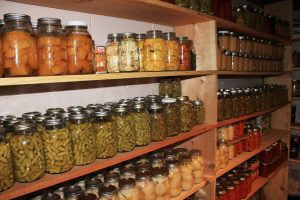
Canned vegetables make up the bulk of our pantry. In the photo above, literally hundreds of jars of tasty vegetables wait to be used in home-cooked meals.
Pickles, relishes, jams, and jellies
Everyone likes treats and sweets. Your pantry should be well-stocked with many flavors of homemade jams, jellies, and pickles. These give every meal a flair. Stock your shelves with your favorites in any amount you like.
I have a special place in our pantry lined with jars of blackberry jelly, orange marmalade, blueberry jam, strawberry jam, and many others. We also have plenty of sweet pickles, bread and butter pickles, and pickle relish to eat with our meals to give them a little kick. I also keep a few jars of pickled peppers to eat on homemade pizza. All of these items are not considered hardcore food storage. They serve mainly as a means of livening up meals with sugar, spice, and vinegar.
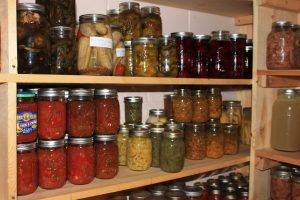
A variety of salsas, relishes, and pickles will help add a little flair to each meal.
Meats
For quite some time now, meat has generally been frozen as the primary storage method for most households. I do not like to freeze meat (or anything else). A freezer can have a mechanical failure, the power can go out, or the food itself can become freezer-burned. I am sure some folks are gagging now at the thought of canned meat. It is not gross at all. Even a picky eater wouldn’t be able to tell the difference in most circumstances. I do not can all of our meats; I still like to leave the steaks, some beef roasts, and a couple packages of ground beef in the freezer to use fresh.
Regardless, for long-term food storage, canned meat is very convenient. It takes the work right out of cooking many meals, and I personally find meat an easy food to can. It allows meals to come together very quickly without the hassle of defrosting and cooking a package of meat. With canned meat, you just need to drain a pint of meat and add that to some tomato sauce, heat it up, and you’ll have a skillet of delicious homemade spaghetti sauce in 15 minutes. Canned meat generally works best in mixed dishes like soups, stews, sauces, casseroles, chicken salad, tacos, and sloppy joes. It is also more cost-effective to home can it, instead of buying it already canned. Canned chicken, right now, is priced around $2 for about a pint of a generic brand.
Starting amounts will need to be figured in the same way as fruits and vegetables. If you eat chicken once a week on average, then you will need to store around 52 jars plus an extra 10%.
We raise poultry and rabbits for meat. We had been buying half of a grass-fed beef for the past couple of years, but it got too expensive. However, next spring we’ll be raising a steer and a few pigs on Dad’s farm to add to our meat supply. Our family also enjoys hunting, which is another great way to lay food on the table. If you can’t raise your own meat, there are several options for folks to utilize, from buying meat from your local farmers to purchasing on sale at the grocery store.
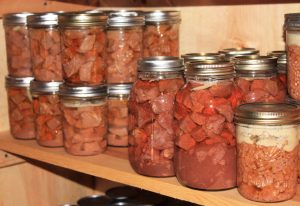
Meat is a great source of protein, and is the base of many meals. My pantry wouldn’t be complete without several jars of chicken, beef, and venison lining the shelves.
Grains, flour, pasta, and legumes
If you are like me, you eat an abundance of grain products every day. You may have oatmeal for breakfast, a sandwich for lunch, and a hot roll to go with your chili. You may have popcorn for a snack later on. All of these meals involve some type of grain or legume. A good long-term food storage pantry will feature an abundant amount of grains, flours, and beans.
These foods are usually very inexpensive to buy and are very nutritious. A good long-term food storage pantry will have white flour, whole wheat flour, wheat berries, popcorn, cornmeal, rolled oats, rice, pasta, and a variety of dry beans. The amount you store will vary from house to house. I like to keep about 300 pounds of white flour, 20 pounds of whole wheat flour, 100 pounds of wheat berries, 50 pounds of popcorn, 20 pounds of cornmeal, 50 pounds of rolled oats, 50 pounds of rice, 25 pounds of spaghetti noodles, 5 pounds of macaroni noodles, 5 pounds of lasagna noodles, 5 pounds of egg noodles, 50 pounds of pinto beans, 10 pounds of white beans, 10 pounds of kidney beans, and 10 pounds of black beans.
The bulk of these foods will keep indefinitely. The oily germ in whole wheat flour and cornmeal will turn the food rancid after about a year of storage. That is why it is important to store an abundance of wheat berries and popcorn in your pantry — both store well and can be ground into flour or meal when needed. A grain mill is also essential to own to process your long-term food storage.
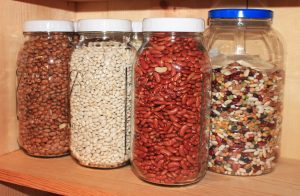
You can keep some dry food in large glass jars on the pantry shelf. Pictured above is a just a small portion of our dry bean stores kept in jars for quick use.
I store these items in food-grade buckets on the pantry floor. You can get these buckets free from department stores and they make excellent storage containers. I also store some of these items in half-gallon jars on the pantry shelf for easy access. If the item was bought in bulk packaging, I empty it into a clean bucket and seal the lid. However, if it was bought in common retail packaging I usually store in the bag (after checking for holes) in a sealed bucket. The storage’s primary goal is to keep the food in and the vermin, bugs, and moisture out. Good storage is essential for a great pantry.
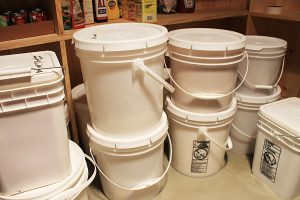
Most bought-in-bulk items have to be removed from their original packaging for storage. I keep our bulk items in large, food-grade, white plastic buckets that have a rubber seal to keep moisture and vermin out.
Dairy and eggs
Most self-reliant families should keep a flock of chickens for eggs and a dairy animal or two. However, in long-term emergency situations, milk, butter, cheese, and eggs may not be available as plentifully as needed. For example, if you lose your main source of income, you may no longer be able to pay the feed bills which will cut off your abundant supply of milk and eggs. A good long-term food storage pantry will be able to battle against that.
As far as I know, there is no proven safe method of dehydrating dairy and eggs at home. However, it has been said that you may be able to can some of these foods such as milk, butter, and cheese. I have not experimented much with this so I cannot tell you either way. If you are interested in learning how to can these foods, you can find instructions in Jackie Clay-Atkinson’s book, Growing and Canning Your Own Food. However, for long-term storage, dehydrated forms of these foods are more favorable due to the fact they take up less space.
Dry milk is the most essential because milk provides many vitamins and nutrients which would be helpful to stay healthy during hard times. Not to mention, without a reliable source of dairy products many meals wouldn’t be possible. I’ve seen numerous survival sites list outrageous amounts of dry milk to keep on hand, and nothing is wrong with large quantity. We go through about a gallon each week with my family cooking heavily from scratch. It takes around four cups of dry milk to make a gallon of milk. This means that for a year’s supply we should have around 55 pounds of dry milk in storage. One of the cheapest ways to acquire dry milk is to get it in large boxes from stores like Walmart and then repackage it for long-term storage in glass jars. It should keep for several years this way, especially if you use an oxygen absorber. You can also buy it in #10 cans from emergency preparedness retailers. I like to keep several cans of canned milk on our pantry shelves for when I put together a quick casserole. They are usually found on sale during the holidays.
It is nearly impossible to find dehydrated eggs, butter, or cheese in the neighborhood grocery stores. These will have to be bought from emergency preparedness retailers. I would advise you to store about two #10 cans of butter and eggs per person in your household. Cheese powder should be stocked based on how much you use. It’s not as important to most recipes, and is more of a treat. You may also want to stock powdered sour cream and buttermilk in appropriate quantities for your family.
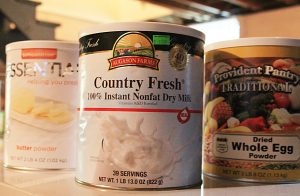
No food storage program is complete without dehydrated eggs, milk, and butter. Several cans will serve you well on your pantry shelves.
Sugar and other sweeteners
Sugar will need to be packaged in much the same fashion as other dry goods. I like to store 100 pounds of white sugar, 15 pounds of brown sugar, 10 pounds of powdered sugar, 2 gallons of honey, 1 gallon of molasses, and 2 gallons of pancake syrup. You’ll find these necessary for cooking. The sugar should be packaged into food-grade buckets, and if possible you can leave it in the original packaging. I keep about 4 buckets of white sugar in our pantry to use frequently. I keep the other bag in a garbage can to protect it from vermin and moisture. I leave my other sugars in their original packaging and pack into clean food-grade buckets for long-term storage. Sugars will harden over time, but they will still be usable.
I keep our honey and molasses in glass jars on the pantry shelf, and I keep a smaller jar upstairs for daily use then add more to it as needed. We buy pancake syrup in bulk from Sam’s Club, and I keep it in the original jugs on the pantry shelf. Molasses and honey will crystalize over time. However, this can be fixed by placing the jar in very hot water to return the crystallized sugar back to liquid.
Cooking essentials
Without cooking essentials, the other storage food is pointless. Good bread is hard to make without yeast unless you use sourdough. Of course, even a simple biscuit can’t be made without baking powder. These pantry staples cannot be grown at home, and a good pantry isn’t complete without them.
I store around 10 pounds of iodized salt, 10 pounds of canning salt, 2 pounds of yeast, 6 pounds of baking powder, 1 pound of baking soda, and 1 pound of cornstarch.
The most important thing when storing these essentials is to keep moisture away. I store our salt in large, recycled jars that hold about five pounds each. I keep a pint jar of yeast in the fridge for daily use, and I keep the other pound in the freezer in order to keep it usable. I get baking powder in 3-pound packages and keep them in the original containers. Most of these will keep for quite a long time; however, baking powder and yeast will lose their leavening power after a while.
Fats and oils
Long-term food storage would not be complete without a good supply of fats and oils.
I store a variety of shortening, lard, peanut butter, vegetable oil, olive oil, broths, and stocks. Shortening, lard, and cooking oil are necessary to make most baked goods. Shortening is said to be good indefinitely, but lard and cooking oil can go rancid (within a year or two) if not rotated regularly. Peanut butter will also last quite a while in storage and is rich in protein, which makes it a very handy “survival food” It is used in a variety of sweets and is good on a slice of homemade bread for a quick lunch.
Most of these staples you can grow or make yourself such as lard, chicken broth, beef broth, and vegetable stock. Broths and stocks help form the bases of many soups and stews, and also can add a nice flavoring to recipes. Things like shortening, and vegetable oil will have to be purchased at retailers. Store as much as you will use in a year. I like to store about six 1-gallon bottles of canola oil, and 2 gallons of olive oil. I use them fairly often. I like to store about eight #10 cans of shortening, and a few jars of lard.
Convenience foods
Generally speaking, this is the least mentioned and sometimes discouraged member of the long-term food storage pantry. However, the real question is why would you not have plenty of convenient meals at your fingertips when disaster strikes? I’m not talking about TV dinners and frozen pizza. In addition to home-canned meals-in-a-jar, I try to stock a variety of cheap convenience foods to make meals quicker during hard times.
I have several jars of home-canned vegetable soup, chili, soup beans, baked beans, tomato soup, and sloppy joes. We use these to make a quick meal after a long day’s work or even as quick lunch. I do not tally it into my long-term storage plan because it doesn’t need to be relied on as heavily. I also stock some cheaply-acquired, store-bought convenience meals in our pantry. I have several boxes of macaroni and cheese plus several packages of ramen noodles for quick side dishes or lunches. It would be good to have a few cans of cream of mushroom soup and cream of chicken soup for quick casseroles. I find it handy to keep a good supply of cheap cake mixes on hand because it is so quick to whip up a good fresh baked cake. I try to get these items either on sale or from bulk shopping clubs.
Water
This is the most important thing to store and have access to. Humans cannot go past three days without water; then we would become severely dehydrated and die. FEMA recommends storing a gallon a day per person. Currently, for our long-term water needs, we collect rain water in a 1000-gallon tank which will provide enough water for our five-person family for 200 days according to FEMA recommendations.
In order to have water in a long-term situation, you need to have a renewable source such as a well or rainwater. Even more important is to have a way to purify it; don’t use it if it hasn’t been purified — you can never be sure what bacteria are lurking in it. For purification, you can use bleach, boil it for ten minutes (at a rolling boil), or purchase a water filtration system. However, if your water supply has any agricultural runoff, neither boiling nor bleach will take care of it. This water would have to be filtered.
Cooking skills
You can store vast amounts of foods, but if you cannot cook with them and prepare them then a well-stocked pantry is of no use to you. It is important to learn skills to prepare meals entirely from your pantry. I’m not just referring to making a light supper, but to a broader array of kitchen skills.
It is imperative to know how to bake. Baking breads, biscuits, cookies, and cakes will be essential if you cannot run to your neighborhood grocery and purchase these products. Baking is a great skill for men or women. Storing large amounts of flour and wheat will mean little to you if you cannot put together a loaf of bread. You’ll also need a way to grind your corn and wheat. So a grain mill is a must have item for long-term food storage.
You’ll need to be able to consciously cook in a frugal manner. Most of us probably do that now anyway. In short, don’t waste food. For instance, if you have a big meal on Sunday with a large roast, plenty of corn, peas, carrots, and potatoes it would be wise to throw this in a pot after you’ve finished and prepare a stew for your lunch and supper. That way none of those foods are thrown out, and you aren’t stuck eating the same food the same way. Many Americans throw away food that is still edible. By “reusing” food you will save tons of edible, tasty food that will turn into a nutritious meal.
Be creative. This is just as essential as any other skill. Learn how to make something out of nothing. Turn your vegetables and grains into works of art that provide a flair and taste that is normally not seen. In a survival situation, the beans and rice every day won’t do anything to improve your attitude.
If you don’t know how to preserve food, now is the time to learn. Preserve foods in ways that are convenient, and that do not require freezing. If a survival situation lasts longer than a year it will be imperative that you can replenish your stockpile. Learn how to preserve foods in an efficient manner. As most of my recommendations are canned items, I suggest you learn how to can different types of food. You will also need to be able to grow these foods. If you don’t garden, learn how to. The stocking guidelines I suggested are primarily based on foods that can be grown or slaughtered on a homestead. That is essential.
You will also need the tools to make the most of your food storage: adequate cookware, a grain mill, canning equipment, several dozen canning lids, a water bath canner (for high-acid foods), and a pressure canner (for low-acid foods). I also suggest you have a back-to-the-basics cookbook to help you along the way. I suggest Jackie Clay’s Pantry Cookbook. It is probably the best one I have ever seen that keeps your family’s comfort and your food storage in mind at the same time.
Cost-effective and smart, that is the best way to describe a stocked, long-term homestead pantry.

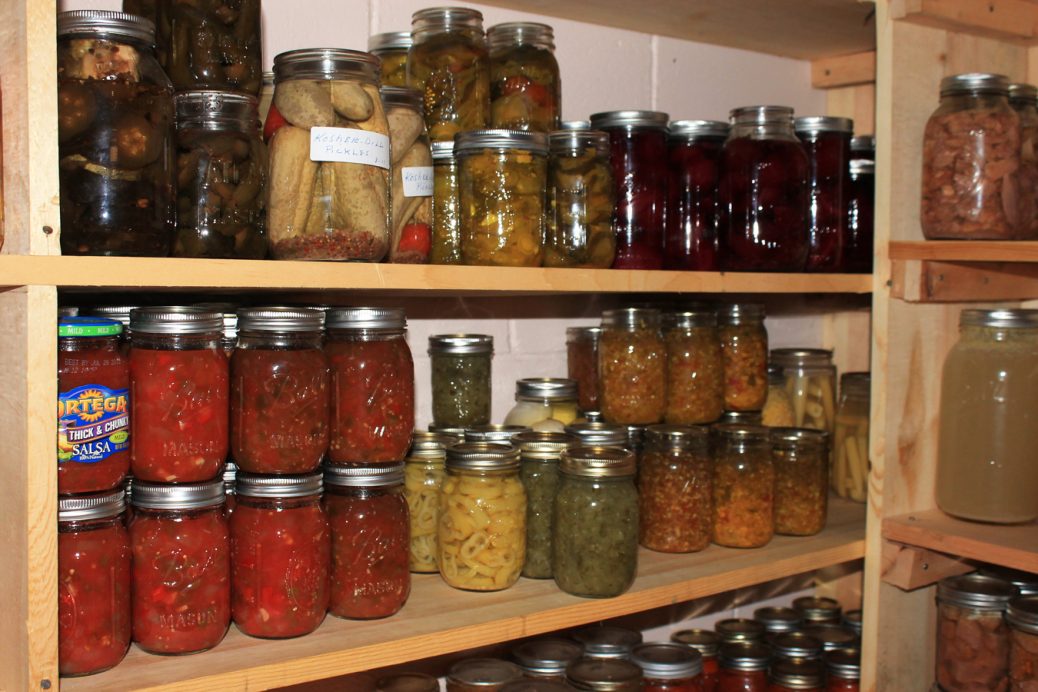
Great article. I spent quite a bit of time vacuum sealing staples in canning jars using my seal a meal. Over half didn’t keep the vacuum and the lids were completely loose. I will have to redo them all using the oxygen absorber method.
I tried using my pressure canner to can my chilli and didn’t have much success. I was completely worried about keeping the pressure right using the canner on the electric stove. I watched it like a hawk the whole time, which is not something I want to do again.
Is it okay to get the canner up to pressure and come back when it’s done or do I need to watch the pressure closely because it’s an electric stove? Any help would be appreciated.
Until recently I was slightly leary of canning meat, but now I do it all the time, homemade chili, ground beef, lightly seasoned chicken pieces and ground, pork/boar/venison pieces in a good sauce, (but no dairy) chicken soup, beef soup etc, the main difference is that its a 75 minutes caning process in a pressure cooker.
Wow, great article – thanks for sharing your knowledge!
I remember well my Nana’s pantry, but I never learned the basics as modern ‘convenience’ replaced old ways. I live in Hawaii now, where we are especially vulnerable to supply chain disruptions. I’m told 30 years ago, 90% of Big Island food was grown here, Today, 90% is shipped in. Oahu has a mere 3 day supply of food!
The pandemic was the Wake Up! call.
Some adjustments for storage in a tropical climate will be needed, but I learned a lot here. Big Mahalo for your detailed, concise and important information.
I was amazed at the depth and detail , moreso when I noted the age of the author.I dont think I will be canning meat anytime soon.We uesd to have canned meat when I was a child.Shudder..
Thanks for a very informative article
Great bit of info and many common questions addressed!
Awesome job!